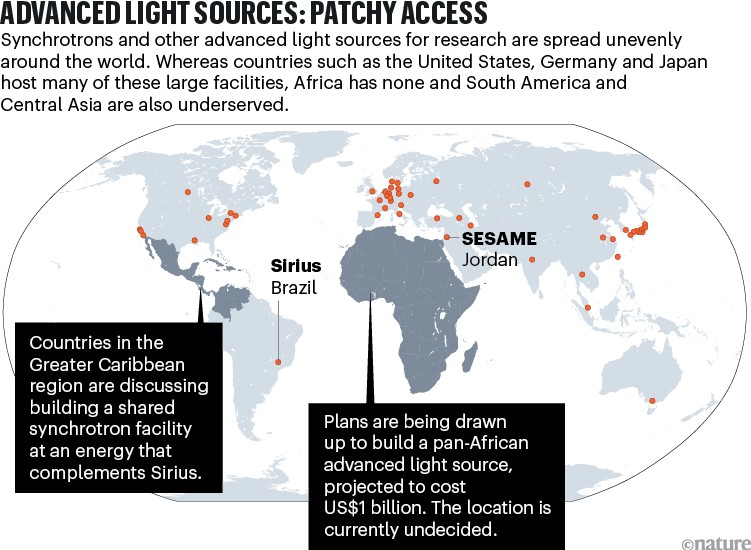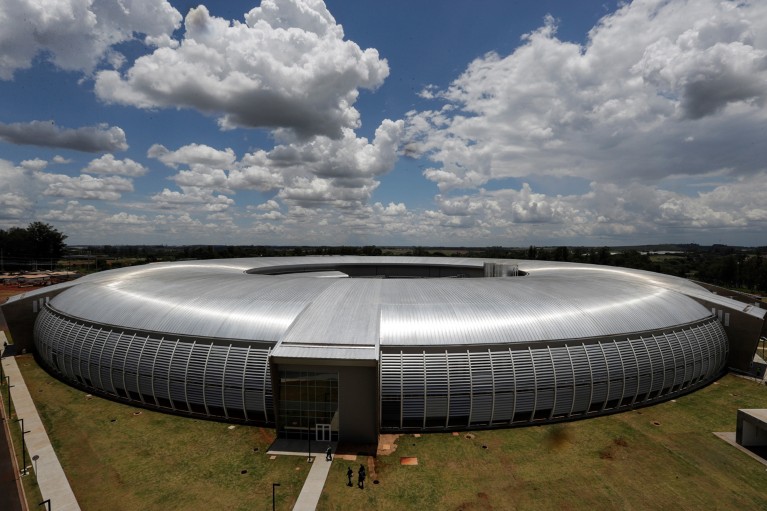Large scientific facilities do more than just deliver breakthroughs — they build capacity. Regions that host them benefit from the creation of jobs and skills as well as infrastructures, from computing to electricity and transport.
The benefits can be especially great for advanced light sources, which generate intense beams of light for a range of uses in academia and industry. Such sources use free-electron lasers or synchrotron radiation (generated by accelerating electrons to near-light speeds around a ring that measures up to 1.5 kilometres in large-scale facilities) to create beams of photons with energies across the electromagnetic spectrum — from X-rays to ultraviolet and infrared wavelengths.
These light beams can be used in condensed-matter physics and to study the structures and properties of materials, catalysts, drugs and vaccines, as well as to characterize soils and follow biological processes. The implications of these studies stretch from climate, energy, health and agriculture to the preservation of cultural heritage.
Yet access to synchrotrons is uneven around the world, and especially scant in low- and middle-income countries (LMICs). In particular, researchers in Africa and the Greater Caribbean — a region including the Caribbean islands, Mexico, Central America, Venezuela and Colombia — struggle to access synchrotrons (see ‘Advanced light sources: patchy access’). Many researchers in Africa and the Greater Caribbean could benefit from these facilities1. Both regions face great social and environmental challenges. They also stand to benefit most from the types of science that synchrotrons enable. Funding remains a challenge, however, as does access to the necessary technologies, infrastructure and staff.

Source: https://lightsources.org
We are part of the Latin American International Synchrotron for Technology, Analysis and Development (LAMISTAD) project, which aims to construct a Greater Caribbean Light Source (GCLS). Established in 20212, this project follows on from a handful of national proposals from Mexico, Colombia and Cuba that struggled to get off the ground individually.
The LAMISTAD project has much in common with that for a pan-African synchrotron facility, the African Light Source (AfLS)3. Both projects have yet to become reality, but the completion of two similar facilities in LMICs in the past seven years is cause for optimism. The SESAME facility (Synchrotron-light for Experimental Science and Applications in the Middle East)4, which opened in 2017 in Jordan and was two decades in the making, is a significant achievement in science diplomacy. This initiative prioritized international cooperation in a region characterized by political sensitivity and diversity. In Campinas, Brazil, a facility called Sirius was inaugurated in 2018 and opened for research in 2020. It played a part in enabling researchers to promptly determine the structures of proteins on the SARS-CoV-2 virus. This was crucial in understanding some aspects of the virus’s behaviour — an important step in the development of drugs against COVID-19.The success of projects of this nature requires support from researchers, policymakers and global organizations that fund scientific development. This is crucial for driving scientific discoveries, but also for addressing regional social and economic challenges. Here, we outline five steps that are necessary to make the Greater Caribbean Light Source a reality.
Choose a site and technical scope
Decisions must be taken over where to put the Greater Caribbean synchrotron. Several sites are being considered. One possibility, yet to be confirmed, is land in the state of Hidalgo, Mexico, that was generously offered by the local government for the country’s previous national initiative. This site is geologically stable, doesn’t present risks to the environment and has good water and electrical supplies. It is accessible by road, rail and air, and has high-speed Internet and modern telecommunications. The eventual choice, however, will depend on political considerations and on existing commitments from the governments of participating countries.
On the technical side, the energy level at which the synchrotron will operate needs to be agreed. The decision must be supported by a council that comprises representatives from all participating countries and be in accordance with the budget. A strong case can be made for opting for a 1.5-gigaelectronvolt (GeV) synchrotron, to complement Sirius’s 3-GeV energy ring. A lower-energy ring would limit the energy achievable in the electromagnetic spectrum, but it is more cost-effective to run. Beyond financial considerations, such low-energy beams also cause less damage to biological and organic materials. They can serve, for example, to determine the chemical composition, structure and atomic environment of samples including soft matter, soil and plants — making them well suited to analytical studies in the fields of biodiversity, water and agriculture.
Clean sources of energy might be considered. SESAME is the first — and so far only — synchrotron facility that runs solely on electricity from renewable sources. This was made possible through a collaboration between Jordan and the European Union. Beyond the environmental benefits, it also saves between US$2 million and $3.75 million per year compared with using conventional energy sources, so is an approach the Greater Caribbean region could emulate.
Make a training plan
Each synchrotron’s success relies on skilled users. Mexico, for example, has such a community, and Brazil’s long previous experience with advanced light sources is an advantage. Before Sirius, Campinas hosted the Southern Hemisphere’s first synchrotron, UVX, which operated between 1997 and 2019. Sirius has built on that legacy, and its scientific network represents a base of initial users for the Greater Caribbean facility. Local specialists can help to train and produce a skilled workforce through courses, workshops, staff exchanges and conferences.
Furthermore, synchrotron techniques are easy to pick up for researchers who are adept in related methods, such as spectroscopy and X-ray studies. International programmes, including the Hercules European School supported by Grenoble Alpes University in France, offer training through lectures, practical sessions, tutorials and visits to key facilities. The example of SESAME shows that it is possible to launch a vigorous, large-scale training programme successfully in a region with scarce experience.
Secure funding
Any major facility requires an enormous up-front investment in construction, equipment and staff. The cost of the 3-GeV pan-African synchrotron, for example, has been put at $1 billion, with running costs of around $100 million per year. Although these are rough estimates, and depend on a variety of factors, such as the energy of the beams, it seems likely that the Greater Caribbean project might be built for a few hundred million dollars and cost around $50 million per year to run. Those costs might be brought down further by relying on solar energy, as SESAME does.
In any case, a wide base of financial support will be needed, from governments of the countries in the region, the private sector and international research and development organizations.
US particle physicists want to build a muon collider — Europe should pitch in
As a flagship for international co-operation, SESAME’s $110-million construction costs were met largely by public funding from multiple sources: Jordan, Israel, Turkey, Iran, the European Union and (in equipment) CERN, Europe’s particle-physics laboratory near Geneva, Switzerland. By contrast, the construction of Sirius in Brazil, which cost $400 million, was financed only by the federal government, and Brazilian firms were involved in 85% of the project. This was a by-product of the previous investment in UVX, which aimed to support the technological development of the country.
The viability of establishing large facilities in LMICs, in light of other social and economic priorities, is often questioned. We argue that the wider benefits are important5 — scientific and societal, but also economic.
Since the first working group on the Greater Caribbean proposal in 2021, the project has garnered increasing interest from leading laboratories around the world. Next, getting support from the UN cultural organization UNESCO is crucial, because it would prompt governments, funders and international organizations to engage in the endeavour.
Other organizations should recognize the role these synchrotrons would have in the areas their missions cover, and lend their support — including financially. These include agencies such as the UN Food and Agriculture Organization, the UN Industrial Development Organization, the UN Development Programme, the European Union, the Organization of American States, the Central American Higher Education Council (CSUCA) and the Caribbean Community (CARICOM), as well as development banks.
Foster interregional cooperation
Collaborations will be crucial for supporting these synchrotrons. African–Latin American cooperation and global south collaborations more generally are strengthening and gaining global recognition (see go.nature.com/48qfypj). During the COVID-19 pandemic, for example, a large part of the Southern Hemisphere supported liberalizing vaccines and temporarily waiving intellectual-property rights for them, a request that originated in India and South Africa.
Such collaborations have been limited in scientific research, however. In this respect, the joint participation of the African Light Source Foundation and the LAMISTAD project in the Cape Town World Science Forum in December 2022 is a milestone. It led to a partnership based on exchanging experiences, participation in conferences (see go.nature.com/3htqkuf) and continuing work towards securing international support for the two light sources. This synergy opens up possibilities for joint training efforts, which would be cost-effective as well as scientifically enriching.
CERN has a long tradition of supporting big-science projects in the global south. In 1993, it encouraged Latin America’s participation in high-energy physics6, and in 2004 launched the HELEN programme (High Energy Physics Latin-American-European Network). These interactions have proved to be mutually beneficial, resulting in advancements throughout Latin America as well as a pool of skilled researchers from the region who can now participate in international experiments, such as CERN’s flagship accelerator, the Large Hadron Collider.
The example of SESAME is motivational — its inception by Nobel laureate Abdus Salam and CERN garnered support as a scientific initiative, and as a way to promote peace in the region and bolster the participation of global south countries in international organizations. It not only received broad support and funding internationally4,7, but also collaborates with the International Centre for Theoretical Physics (ICTP) in Trieste, which Salam founded, through training scholarships and visiting agreements. The African and Greater Caribbean synchrotron projects might seek to establish similar collaborations.
Get together
Discussions to lead projects on this scale are difficult to do in person because of the number of people involved, the distances between participating countries and the need to engage local and national authorities. Virtual and hybrid events can help8. For example, in May and June 2023, the LAMISTAD project organized a hybrid event in Colombia, Jamaica, Spain, Mexico, El Salvador and the Dominican Republic over six days to put together the backbone of its proposal (see go.nature.com/42tpcdy).
Each host country focused on its specific interests in synchrotron radiation techniques, from fundamental research in physics and the preservation of cultural heritage to agriculture, climate and health applications. This format allowed both governmental and scientific involvement, and fostered international cooperation and local participation.
The session held in Spain emphasized the role of the Greater Caribbean scientific diaspora in Europe. These researchers could have a key role in enabling inter-regional collaborations, participating in training workshops, advising scientific committees or hosting research visits in the country they work in.
Hopefully, the LAMISTAD project will receive the societal and political endorsement it deserves. That the network has already become established among researchers from across Latin and South America as well as Africa is already a positive outcome. It is also a testimony to its vast possibilities.


 US particle physicists want to build a muon collider — Europe should pitch in
US particle physicists want to build a muon collider — Europe should pitch in
 Plan for Africa’s first synchrotron light source starts to crystallize
Plan for Africa’s first synchrotron light source starts to crystallize
 African researchers’ work is being overlooked — here’s how to change that
African researchers’ work is being overlooked — here’s how to change that
 Pack up the parachute: why global north–south collaborations need to change
Pack up the parachute: why global north–south collaborations need to change








